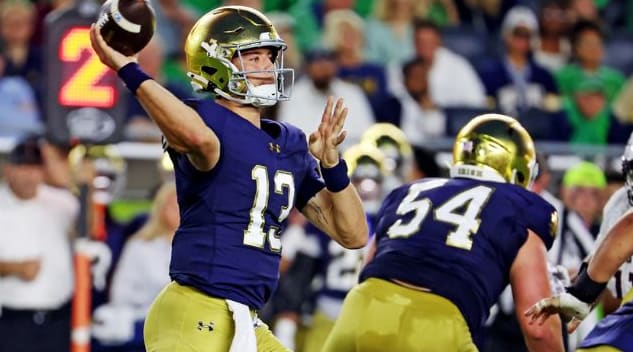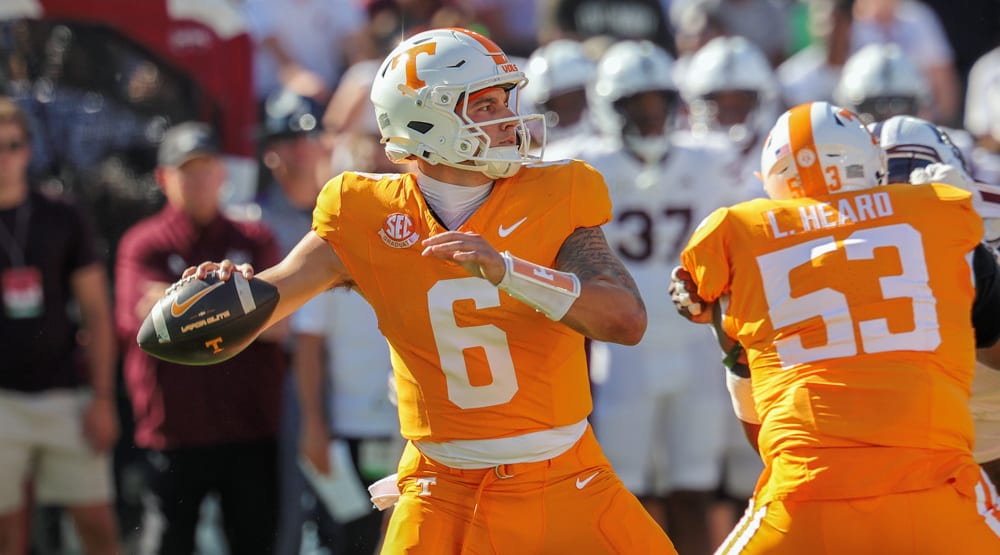The NFL is a passing league. We all know it. As a result, the highest priorities are placed on finding a franchise quarterback, protecting that quarterback, and applying pressure to opposing quarterbacks. We see this play out every April at draft time when the gunslingers, hogs, and sack-masters take precedence for top picks. This emphasis on the passing game has drastically reduced the demand for running backs.
Things weren't always this way, however. Not too long ago there was an emphasis on finding a "workhorse back," and selections at the top of the draft reflected this. In the four years from 2005-08 a running back was taken in the top-7 each year and there were a total of six taken that high ('05-Ronnie Brown, Cedric Benson, Cadillac Williams, '06-Reggie Bush, '07-Adrian Peterson, '08-Darren McFadden). But the game has changed.
With new rules limiting the physicality of defensive backs and the consequent growth of spread-out, pass-heavy playcalling, the ground-and-pound approach is nearly extinct. The value associated with having a feature back has diminished greatly, and there has been just one runner (Trent Richardson) taken in the top-7 in the four drafts since 2008. The pounding these guys take generates legitimate durability concerns, and the committee attacks adopted by many teams have hurt the draft stock of backs, as well.
That's not to say having a productive ground game is no longer important. Take a look at the best teams in the NFL and they still have balance – Baltimore, San Francisco,
The NFL is a passing league. We all know it. As a result, the highest priorities are placed on finding a franchise quarterback, protecting that quarterback, and applying pressure to opposing quarterbacks. We see this play out every April at draft time when the gunslingers, hogs, and sack-masters take precedence for top picks. This emphasis on the passing game has drastically reduced the demand for running backs.
Things weren't always this way, however. Not too long ago there was an emphasis on finding a "workhorse back," and selections at the top of the draft reflected this. In the four years from 2005-08 a running back was taken in the top-7 each year and there were a total of six taken that high ('05-Ronnie Brown, Cedric Benson, Cadillac Williams, '06-Reggie Bush, '07-Adrian Peterson, '08-Darren McFadden). But the game has changed.
With new rules limiting the physicality of defensive backs and the consequent growth of spread-out, pass-heavy playcalling, the ground-and-pound approach is nearly extinct. The value associated with having a feature back has diminished greatly, and there has been just one runner (Trent Richardson) taken in the top-7 in the four drafts since 2008. The pounding these guys take generates legitimate durability concerns, and the committee attacks adopted by many teams have hurt the draft stock of backs, as well.
That's not to say having a productive ground game is no longer important. Take a look at the best teams in the NFL and they still have balance – Baltimore, San Francisco, New England, Seattle, Washington and Houston were all in the top-11 in terms of 2012 rushing yardage. It's also not to say rookie backs are always a bad investment. Case in point, Alfred Morris' 1,613 yards and 13 touchdowns last season were a big reason the Redskins make the playoffs for the first time in five years.
But Morris was available in the sixth round, while first-round investments like Doug Martin (1,454 yards, 11 TDs) and the aforementioned Richardson (950 yards, 11 TDs) saw their teams miss the playoffs. The previously mentioned playoff teams built their running games on the likes of Morris, Ray Rice (second round), Frank Gore (third round), Stevan Ridley (third round) and Arian Foster (undrafted), with Seattle's Marshawn Lynch being the only first-round pick of the group. The lesson is clear: you don't need to pick a running back in the first round to dominate on the ground.
This year's class doesn't have a prospect on the level of Richardson, but there are talented options in the second and third days of the draft who will make their mark on the league. Running back is perhaps the top plug-and-play position for rookies, and as happens every year, a handful of these guys will have an impact in 2013. Look for a large number of backs to fly off the board between rounds two and four. Let's break 'em down. I've provided comparisons to other NFL running backs, but keep in mind these are parallels based on style, not necessarily talent level.
1. Eddie Lacy, Alabama (5-11, 231)
2012 season (junior): 1,322 rushing yards, 6.5 YPC, 17 rushing touchdowns
A lot of Lacy's stock depends on how fast he runs the 40-yard dash. He's currently dealing with a nagging hamstring issue that prevented him from participating at the combine and at Alabama's pro day. If he can run in the 4.5-range I feel confident with him as the best overall back. He's one of the few prospects with the size and skills to be considered a three-down starter at the next level. Lacy shows nice patience through the hole and solid power, but he runs a bit upright and lacks the explosiveness and lateral quickness to be a true difference-maker in the NFL.
NFL Comparison: Steven Jackson
2. Montee Ball, Wisconsin (5-10, 214)
5,140 rushing yards, 77 rushing touchdowns over four years
Ball didn't test out particularly well (4.66-40 at the Combine), but the proof is in the pudding. He's a natural runner with good one-cut zone-rushing ability that is popular in the league right now. He doesn't have deep speed or overwhelming power, but shows good vision, downhill explosion to get through the hole, and natural hands. He's a straight-ahead runner without great wiggle, but he'll move the chains.
NFL Comparison: Clinton Portis
3. Marcus Lattimore - South Carolina (5-11, 221)
1,197 rushing yards, 17 rushing touchdowns as freshman (1,480 rushing yards, 21 rushing touchdowns over next 16 games)
Lattimore is the biggest risk-reward running back in this class. Many thought the gruesome knee injury he suffered last fall would end his career, but he's already working out for teams on a limited basis. The upside with Lattimore is clear. He's big and fast, and was very productive when healthy. He's a bit lanky and runs somewhat reckless, but he has great natural moves and instincts. A roll of the dice on Lattimore could be a wasted pick, but he's arguably the top talent at the position in this draft.
NFL Comparison: Darren McFadden
4. Johnathan Franklin, UCLA (5-10, 205)
2012 season (senior): 1,734 rushing yards, 13 rushing touchdowns
Franklin seems to be undervalued, but he was monstrously productive in 2012 and ran a 4.49 in the 40 at the Combine. He's a bit on the smaller side and might not hold up to a full workload without adding some weight, but those ahead of him on most boards lack ideal size, as well. Franklin is fun to watch. He has good moves, is an excellent cutter and has great vision. Despite his smaller stature, he displays impressive lower body strength and leg-drive to run through arm tackles. He is a natural catcher of the ball and will be able to contribute on third downs and on special teams immediately. The main concern with Franklin is ball security, as he was remarkably prone to fumbles prior to correcting the issue in 2012.
NFL Comparison: Ray Rice-lite
5. Giovani Bernard, North Carolina (5-8, 202)
2,481 rushing yards, 25 rushing touchdowns, 92 receptions, 852 receiving yards, six receiving touchdowns over final two years
Bernard is a dynamic playmaker in a small package. His size might keep him from being a bell cow, but he'll make some noise in a part-time role. First off, he'll be a great punt returner. He has incredibly quick feet and dynamic lateral shiftiness. He shows the same traits running out of the backfield and he'll be effective from the spread formation and as a pass-catcher in space. In the right system, Bernard will thrive.
NFL Comparison: Darren Sproles
6. Le'Veon Bell, Michigan State (6-1, 230)
2012 season (junior): 1,793 rushing yards, 12 rushing touchdowns
Bell is a big dude, but he moves well. He ran a 4.60-40 at the Combine and has some nice moves - his favorite being the leap, but he also utilizes a very solid spin-move and a decent stiff-arm. He also has good hands for a guy his size and he should be able to contribute on all three downs. He lacks deep speed, doesn't have great change-of-direction ability and runs a bit upright, but Bell has smooth lateral movements and excellent vision.
NFL Comparison: Eddie George
7. Andre Ellington, Clemson (5-9, 199)
Back-to-back 1,000-yard rushing seasons, 33 career rushing touchdowns, 59 career receptions
Ellington plays faster than what he ran at the Combine (4.61-40) and has the knack for breaking the big play. His best quality might be his uncanny balance, but he has great open-field vision and cutback ability as well. His lack of size will make getting to that open space difficult and limit his effectiveness between the tackles, but he catches the ball very well and should be a weapon out of the backfield from Day 1. Ellington hurt his hamstring at the Combine, though, and he had quite a bit of durability trouble at Clemson, too.
NFL Comparison: slower Chris Johnson
8. Mike Gillislee, Florida (5-11, 208)
2012 season (senior): 1,152 rushing yards, 10 rushing touchdowns
There's only one year of starter production with Gillislee, which is a concern. He also plays smaller than his listed size would suggest. That said, he ran a solid 4.55-second 40 at the Combine and looked very explosive and quick to high gear on tape. Gillislee doesn't profile as an every-down back, but he could be useful as a change-of-pace runner.
NFL Comparison: Ronnie Hillman
9. Kerwynn Williams, Utah State (5-8, 195)
2012 season (senior): 1,512 rushing yards, 15 rushing touchdowns, 697 receiving yards, five receiving touchdowns
Williams had to sit behind Robert Turbin and wait his turn, but when he got the rock in 2012, he made his mark. He might be a part-time player in the NFL, but he brings plenty to the table. Despite his size, he's a very strong runner and his versatility gives him the opportunity to make an impact at the next level in a variety of ways. His 45 catches from a year ago display his abilities as a receiver and he was successful as a kick returner as a sophomore. He's probably too small as a runner to be a three-down asset in the pros, but he plays bigger than he measures, has an effective stiff-arm, and finishes runs well.
NFL Comparison: Jacquizz Rodgers
10. Kenjon Barner, Oregon (5-9, 196)
2012 season (senior): 1,767 rushing yards, 21 rushing touchdowns
Barner's NFL comparison below is not an exercise of laziness. His skill set is very similar to that of his former teammate, right down to their physical stature and running style. Barner is a fluid, fast-enough (4.52-second 40 at the Combine) back who excels running around the edge, but he's shown a decent ability to weave through traffic as well. He probably doesn't have as much all-around upside as the next guy on this list, but you know what you'll get with Barner. He'll contribute immediately as a returner and can be worked into sub packages as a change-of-pace back as well.
NFL Comparison: LaMichael James
11. Christine Michael, Texas A&M (5-10, 220)
2012 season (senior): 417 rushing yards, 12 rushing touchdowns, 34 career rushing touchdowns
Michael is this year's workout warrior. He possesses ideal size, put up 27 reps in the bench press, jumped 10-foot-5 in the broad jump, and launched 43 inches in the vertical jump at the Combine. The former blue chip recruit is definitely an elite athlete, but Michael is a big question mark when it comes to durability and character. He suffered season-ending injuries in 2010 (broken leg) and 2011 (torn ACL), and he was benched in 2012 after opening the season with a suspension. Texas A&M coach Kevin Sumlin is very well respected, so the fact that Michael got into Sumlin's doghouse reflects poorly upon the runner. He also overslept and missed two team interviews at the Combine.
NFL Comparison: Pierre Thomas
12. Stepfan Taylor, Stanford (5-9, 214)
4,300 rushing yards, 40 rushing touchdowns, 97 receptions, 778 receiving yards, five receiving touchdowns in four years
Taylor is a lunch-pail type of guy. He's not going to blow you away with speed, size or moves, but he's going to show up to work everyday and give you his best. He's obviously a smart guy having gone to Stanford, he's played in a pro-style offense and is well-respected for his pass-protection ability, which is crucial in the pass-happy NFL. For a guy who tested slowly (4.76-second 40 at the Combine), he doesn't jump off the tape as a plodder. He makes nice moves in the hole and shows decent elusiveness. He'll be a reliable backup who can help in passing situations.
NFL Comparison: Chester Taylor





















